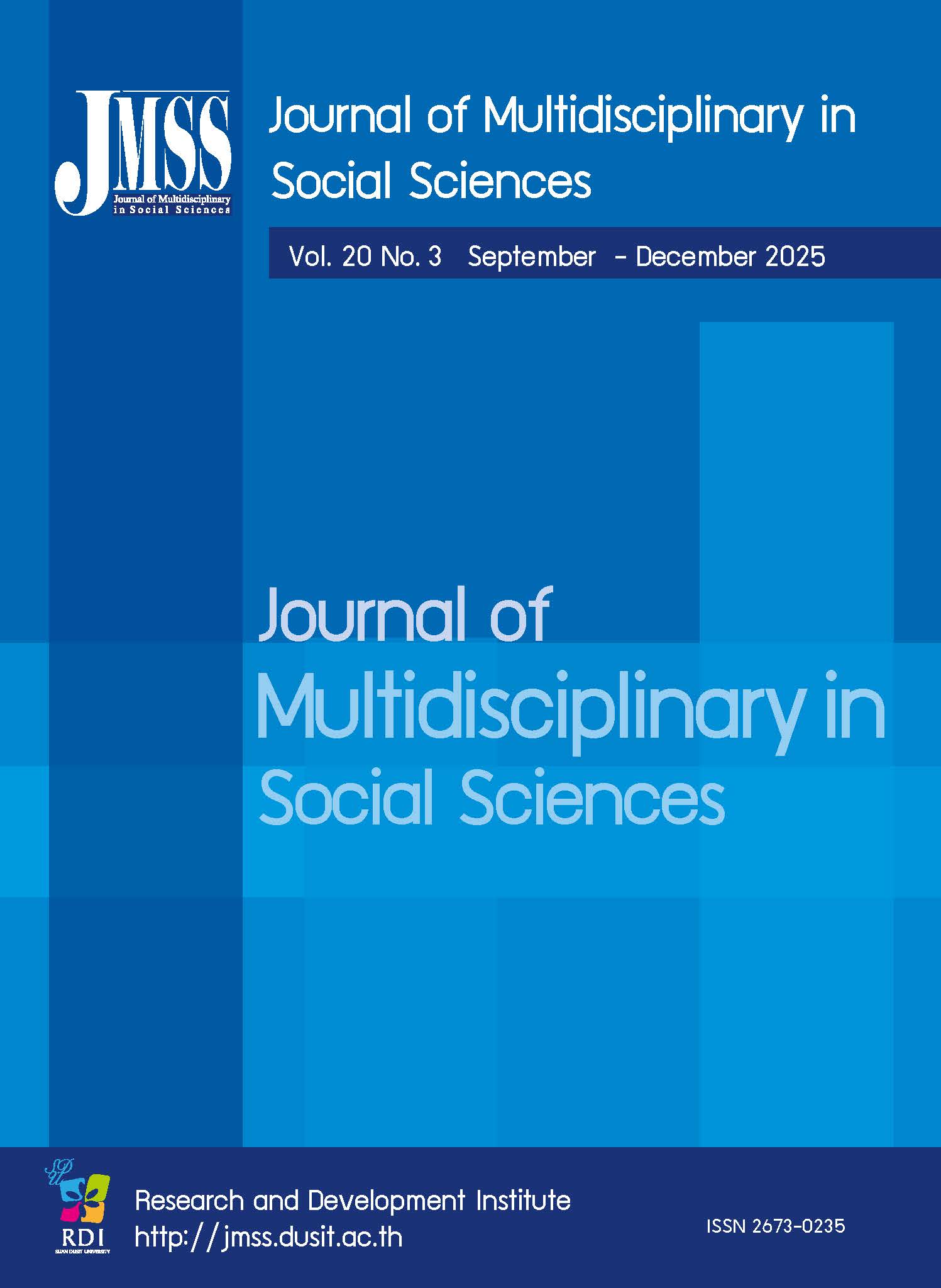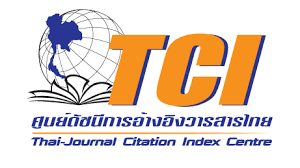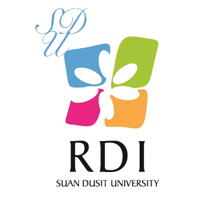Sensory Characteristics of Thong Pha Phum GI Rambutan to Approach the Future Product Based on the Perceptions and Experiences of Various Consumer Groups
Keywords:
Thong Pha Phum GI rambutan, Idea product development, Experience, Perception of consumerAbstract
This study aims to investigate the conceptualizations of product development for Thong Pha Phum GI rambutan based on the perceptions and experiences of various consumer groups —culinary chefs (n=20), producers (n=20), academics (n=20), and general public (n=20), and to explore the emotional responses and wellness perceptions related to the future Thong Pha Phum GI rambutan product. The interview questions were designed to focus on the material's pain points, solutions, and overall concept as well as the emotional responses and wellness perceptions. According to the findings, four consumer groups can be distinguished, each with unique concepts to address their needs and produce novel products and uses of Thong Pha Phum GI rambutan. The generation of ideas is influenced by experience. The academic experts and producers discussed the production of the new products using high technology and innovation while the general public and the group of chefs focused on the ready-to-eat products. Exploring the emotional responses and wellness perceptions through corresponding analysis revealed that most people (from 4 different groups) appreciated and interpreted the Thong Pha Phum GI rambutan product as healthy, relaxing, energetic, satisfying, evoking happy and joyful emotional responses. This research offered consumer insights related to Thong Pha Phum GI rambutan material and unique products, which could be valuable for positioning and marketing of regional foods. It can also guide producers in the food industry.
References
Afzaal, M., Saeed, F., Bibi, M., Ejaz, A., Shah, Y. A., Faisal, Z., Ateeq, H., Akram, N., Asghar, A., & Shah, M. A. (2023). Nutritional, pharmaceutical, and functional aspects of rambutan in industrial perspective: An updated review. Food Science & Nutrition, n/a(n/a).
Bhatta, S., Stevanovic Janezic, T., & Ratti, C. (2020). Freeze-Drying of Plant-Based Foods. Foods, 9(1), 87.
Bilro, R. G., Loureiro, S. M. C., & Souto, P. (2023). A systematic review of customer behavior in business-to-business markets and agenda for future research. Journal of Business & Industrial Marketing, 38(13), 122–142.
Chen, K., Zhang, M., Bhandari, B., Sun, J., & Chen, J. (2021). Novel freeze drying based technologies for production and development of healthy snacks and meal replacement products with special nutrition and function: A review. Drying Technology, 40, 1–16.
Chen, L., Jiang, M., Jia, F., & Liu, G. (2021). Artificial intelligence adoption in business-to-business marketing: Toward a conceptual framework. Journal of Business & Industrial Marketing, 37(5), 1025–1044.
Cheok, C. Y., Mohd Adzahan, N., Abdul Rahman, R., A., N. H., Hussain, N., Sulaiman, R., & Chong, G. hean. (2016). Current Trends of Tropical Fruit Waste Utilization. Critical Reviews in Food Science and Nutrition, 58.
Department of Industrial Promotion. (2021). Quality from the perspective of manufacturers and customers. Retrieved May 20, 2023, from https://www.dip.go.th/th/category/2020-05-26-19-14-36/2021-11-29-09-52-48
EFSA Panel on Biological Hazards (BIOHAZ Panel), Koutsoumanis, K., Alvarez-Ordóñez, A., Bolton, D., Bover-Cid, S., Chemaly, M., Davies, R., De Cesare, A., Herman, L., Hilbert, F., Lindqvist, R., Nauta, M., Peixe, L., Ru, G., Simmons, M., Skandamis, P., Suffredini, E., Castle, L., Crotta, M., … Allende, A. (2022). The efficacy and safety of high-pressure processing of food. EFSA Journal, 20(3), e07128.
Febrianto, N., Yang, T., & Wan Nadiah, W. (2016). Cocoa-like flavor compound development of rambutan seed fat as the effect of fermentation and roasting. International Food Research Journal, 23, 2179–2187.
Guenzi, P., & Troilo, G. (2006). Developing marketing capabilities for customer value creation through Marketing–Sales integration. Industrial Marketing Management, 35, 974–988.
Guiné, R. P. F., Florença, S. G., Barroca, M. J., & Anjos, O. (2020). The Link between the Consumer and the Innovations in Food Product Development. Foods, 9(9), 1317.
Hanmontree, P., Prinyawiwatkul, W., & Sae-Eaw, A. (2022). Emotion and Wellness Profiles of Herbal Drinks Measured Using Different Questionnaire Designs. Foods, 11(3), Article 3.
Held, D., McGrew, A., Goldblatt, D., & Perraton, J. (1999). Globalization on JSTOR. Retrieved May 15, 2023, from https://www.jstor.org/stable/27800244
Jaki Mamat, M., & Abdul Aziz, M. F. (2018). Relationships of Early British Amenities with the Formation of Small Towns in Perak. IOP Conference Series: Materials Science and Engineering, 401, 012007.
Jiang, Y., King, J. M., & Prinyawiwatkul, W. (2014). A review of measurement and relationships between food, eating behavior and emotion. Trends in Food Science & Technology, 36(1), 15–28.
Latest Business Trends & Insights. (2023). Rambutan Market Future Vision 2023-2031: Growth Prospects, Technology Evolution, and Revenue Trends. Received May 15, 2023, from https://www.linkedin.com/pulse/rambutan-market-future-vision-2023-2031
Lewrick, M., Link, P., & Leifer, L. (2020). The Design Thinking Toolbox: A Guide to Mastering the Most Popular and Valuable Innovation Methods. Hoboken: John Wiley & Sons.
Mok, W. K., Tan, Y. X., & Chen, W. N. (2020). Technology innovations for food security in Singapore: A case study of future food systems for an increasingly natural resource-scarce world. Trends in Food Science & Technology, 102, 155–168.
Rujopakarn, B. (2018). Kanchanaburi to register geographical indication of Thong Pha Phum Rambutan. Retrieved May 10, 2023, from https://thainews.prd.go.th/th/news/detail/WNECO6109170010013
Salakpetch, S. (2005). RAMBUTAN PRODUCTION IN THAILAND. Acta Horticulturae, 665, 67–72.
Shamsuddoha, A. K., & Yunus Ali, M. (2006). Mediated effects of export promotion programs on firm export performance. Asia Pacific Journal of Marketing and Logistics, 18(2), 93–110.
Sukasih, E. & Setyadjit. (2015). Development of New Product: Rambutan Pulpy Juice. Procedia Food Science, 3, 413–425.
Sunshine International Co., Ltd. (2020). Rambutan fruit powder. Retrieved May 20, 2023, from https://www.sunshine-th.com/2020/05/09/rambutan-fruit-powder-2/
Thonyim, N., & Rojanatip, J. (2019). Thong pha phum rambutan. https://www.technologychaoban.com/bullet-
news-today/article_115236
Troilo, G., De Luca, L., & Guenzi, P. (2009). Dispersion of influence between Marketing and Sales: Its effects on superior customer value and market performance. Industrial Marketing Management, 38, 872–882.
Vasileiou, K., Barnett, J., Thorpe, S., & Young, T. (2018). Characterising and justifying sample size sufficiency in interview-based studies: Systematic analysis of qualitative health research over a 15-year period. BMC Medical Research Methodology, 18(1), 148.
Wongthahan, P., Sae-Eaw, A., & Prinyawiwatkul, W. (2020). Sensory lexicon and relationships among brown colour, saltiness perception and sensory liking evaluated by regular users and culinary chefs: A case of soy sauces. International Journal of Food Science & Technology, 55(7), 2841–2850.
Downloads
Published
How to Cite
Issue
Section
License
Copyright (c) 2024 Journal of Multidisciplinary in Social Sciences

This work is licensed under a Creative Commons Attribution-NonCommercial-NoDerivatives 4.0 International License.








